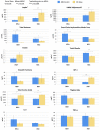Effects of HIV infection on the metabolic and hormonal status of children with severe acute malnutrition
- PMID: 25050734
- PMCID: PMC4106836
- DOI: 10.1371/journal.pone.0102233
Effects of HIV infection on the metabolic and hormonal status of children with severe acute malnutrition
Abstract
Background: HIV infection occurs in 30% of children with severe acute malnutrition in sub-Saharan Africa. Effects of HIV on the pathophysiology and recovery from malnutrition are poorly understood.
Methods: We conducted a prospective cohort study of 75 severely malnourished Ugandan children. HIV status/CD4 counts were assessed at baseline; auxologic data and blood samples were obtained at admission and after 14 days of inpatient treatment. We utilized metabolomic profiling to characterize effects of HIV infection on metabolic status and subsequent responses to nutritional therapy.
Findings: At admission, patients (mean age 16.3 mo) had growth failure (mean W/H z-score -4.27 in non-edematous patients) that improved with formula feeding (mean increase 1.00). 24% (18/75) were HIV-infected. Nine children died within the first 14 days of hospitalization; mortality was higher for HIV-infected patients (33% v. 5%, OR = 8.83). HIV-infected and HIV-negative children presented with elevated NEFA, ketones, and even-numbered acylcarnitines and reductions in albumin and amino acids. Leptin, adiponectin, insulin, and IGF-1 levels were low while growth hormone, cortisol, and ghrelin levels were high. At baseline, HIV-infected patients had higher triglycerides, ketones, and even-chain acylcarnitines and lower leptin and adiponectin levels than HIV-negative patients. Leptin levels rose in all patients following nutritional intervention, but adiponectin levels remained depressed in HIV-infected children. Baseline hypoleptinemia and hypoadiponectinemia were associated with increased mortality.
Conclusions: Our findings suggest a critical interplay between HIV infection and adipose tissue storage and function in the adaptation to malnutrition. Hypoleptinemia and hypoadiponectinemia may contribute to high mortality rates among malnourished, HIV-infected children.
Conflict of interest statement
Figures


References
-
- Black RE, Allen LH, Bhutta ZA, Caulfield LE, de Onis M, et al. (2008) Maternal and child undernutrition: global and regional exposures and health consequences. Lancet 371: 243–260. - PubMed
-
- Caulfield LE, de Onis M, Blossner M, Black RE (2004) Undernutrition as an underlying cause of child deaths associated with diarrhea, pneumonia, malaria, and measles. Am J Clin Nutr 80: 193–198. - PubMed
-
- Fergusson P, Tomkins A (2009) HIV prevalence and mortality among children undergoing treatment for severe acute malnutrition in sub-Saharan Africa: a systematic review and meta-analysis. Transactions of the Royal Society of Tropical Medicine and Hygiene 103: 541–548. - PubMed
-
- Chinkhumba J, Tomkins A, Banda T, Mkangama C, Fergusson P (2008) The impact of HIV on mortality during in-patient rehabilitation of severely malnourished children in Malawi. Transactions of the Royal Society of Tropical Medicine and Hygiene 102: 639–644. - PubMed
Publication types
MeSH terms
Substances
Grants and funding
LinkOut - more resources
Full Text Sources
Other Literature Sources
Medical
Research Materials
Miscellaneous

